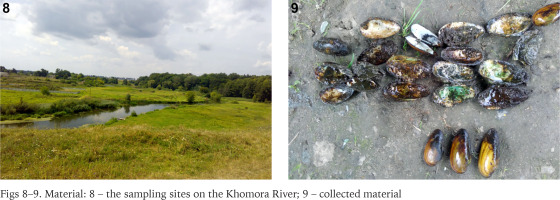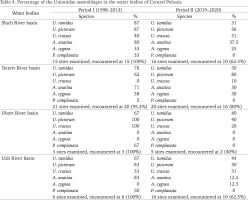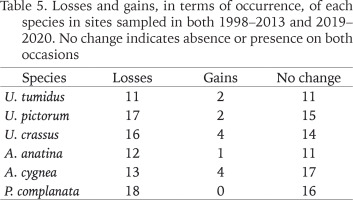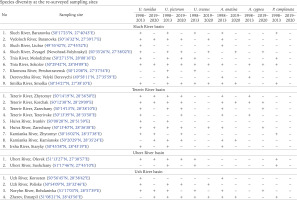INTRODUCTION
Central Polissia is part of the Polissia natural-geographical region with distinctive natural landscapes (Popov 1968) that are threatened by the extinction of numerous species as a result of climate change, infrastructure development, wetland drainage, intensive forestry, illegal mining, and unbalanced use of resources. The climate and topography of Central Polissia cause significant watering of the region. More than 220 rivers run through the area in full or in part, creating a vast river network. The region’s four largest rivers are Teteriv, Sluch, Ubort, and Uzh (Danylova 2019). These rivers have undergone substantial anthropogenic change, as have the water bodies that make up their basins. The anthropogenic changes vary in each river basin.
The Teteriv River, a right tributary of the Dnieper River that flows into the Kyiv Reservoir, is one of the major rivers in the region. The Vidsichne Reservoir on the river provides water to the water supply system in Zhytomyr. Water from the Teteriv River is also used in other cities of Zhytomyr Oblast. Due to flow regulation and transformation into a reservoir system, the Teteriv River is now the most tightly regulated water body in the region. Five small reservoirs have been built along the river to supply drinking water to the residents of nearby settlements. There are a total of 31 reservoirs on the Teteriv River. Large-scale hydraulic construction on the river started in the 1930s and continued until the 1970s. Both large and small rivers were dammed, and over time, they turned into an interconnected system of ponds. Lack of current caused increasing eutrophication of the water bodies, the accumulation of significant thicknesses of silt, the depletion of the oxygen regime, and eventually the extinction of many groups of aquatic organisms.
The Sluch River, a tributary of the Prypiat River, was considered one of the cleanest rivers in Central Polissia in the early 2000s. There has been a drastic change: on April 14, 2016, an unknown substance was released from the Khmelnystskyi regions’ Poninka cardboard and paper factory (Yaroshchuk 2019). This resulted in mass extinction of fish, crayfish, and other species. Use of water, catching fish and crayfish, and providing water to cattle and poultry was forbidden. More recently, it was reported that pollution has dropped.
Since 2014, illegal amber mining has been taking place in the Ubort River basin, significantly altering the region’s natural landscapes (Kobzar 2016) even despite the fact that the Polissia Reserve is situated nearby. Forests were cut down, and water from natural reservoirs was used to wash out amber. River shrinkage and complete drying-out have become quite common. As a result, valuable fish species disappeared.
The Uzh River basin is still being used for mining titanium ore, causing small rivers and wells in numerous settlements to dry up. It is anticipated that the region will eventually turn into a desert (Moskvychova 2013). The current situation in Central Polissia, which has existed for at least ten years, has the potential to completely destroy the natural beauty of this unique region.
Significant changes in the environment of the Polissia region of Ukraine over the last decade have resulted in large-scale changes in the region’s freshwater malacofauna (Yanovych et al. 2008). The Unionidae family of bivalves has always been part of the hydroecosystems of Ukraine (Belke 1853, Jachno 1870, Radkevych 1878, Kessler 1882, Lindholm 1929, Puzanov 1925, Stadnichenko 1984), but pollution of water bodies and disappearance of their typical habitats have caused a loss of populations, to the extent that some are becoming endangered. The issue of preserving the Unionidae and increasing their assemblages is a major concern in many European countries (Geist & Hawkins 2016, Lopes-Lima et al. 2017, Ferreira-Rodríguez et al. 2019, Reid et al. 2019, Zając et al. 2019, Ożgo et al. 2020).
Until recently, the Unionidae have been the group of filter feeders with the highest biomass in Ukrainian river ecosystems, defining the ability of hydroecosystems to self-purify. These mussels play the role of “ecosystem engineers”, create the environmental conditions required for the existence of other aquatic organisms (Gutiérrez et al. 2003, Aldridge et al. 2007, Geist 2010, Chowdhury et al. 2016, Richter et al. 2016, Ilarri et al. 2018), and also act as species indicators (NOAA 2015, Shevchuk et al. 2021). The primary goal of this research was to assess the current state of the Unionidae assemblages in the river system in Central Polissia, by surveying typical unionid habitats in the basins of the rivers Sluch, Teteriv, Ubort, and Uzh in two periods: between the years 1998 and 2013 (Period I) and between 2019 and 2020 (Period II). The data obtained can be used to predict potential changes in the local freshwater ecosystems (Johnson et al. 2020).
MATERIAL AND METHODS
Samples were made to find the six species of Unionidae native to the region, Unio pictorum Linnaeus, 1758, U. tumidus Philipson, 1788, U. crassus Philipsson, 1788, Anodonta anatina Linnaeus, 1758, A. cygnea Linnaeus, 1758 and Pseudanodonta complanata Rossmassler, 1835) (Figs 1–6). The collection of samples was carried out in two periods: 1998–2013 and 2019–2020 with the use of the same method (Table 1). The results of 2019–2020 sampling in the basins of the rivers Teteriv, Sluch, Ubort and Uzh on the territory of Zhytomyr Polissia were compared with the results of the samples taken in 1998–2013. The material was collected by L. Shevchuk between 1998 and 2013, and by L. Shevchuk and L. Bilina between 2019 and 2020. 24 sites (53% of the total number of the study sites in 1998–2013) were re-examined in 2019–2020. Where the location of a site sampled in 1998–2013 could not be precisely located, other sites were sampled nearby. A total of 78 sites were sampled overall (Fig. 7). All data relating to the samples is held in the database GBIF (Harbar et al. 2021).
Figs 1–6
Species of the Unionidae family: 1 – Unio tumidus, 2 – U. pictorum, 3 – U. crassus, 4 – Anodonta cygnea, 5 – A. anatina, 6 – Pseudanodonta complanata. Scale bar 10 mm
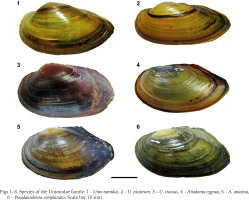
Fig. 7
Location of the sampling sites in 1998–2013 and 2019–2020 periods (red marks indicate sites of 1998–2013 where sampling was not repeated in 2019–2020; green marks indicate sites of 1998–2013 re-surveyed in 2019–2020; yellow marks indicate sites first surveyed in 2019–2020)
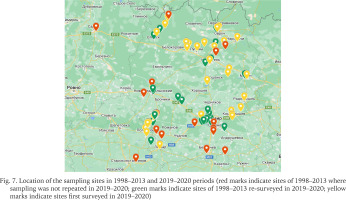
The molluscs were collected by hand at the depth of 0.1–2 m during the warm season (Figs 8–9). Samples were taken three times from an area of 1 m2. Identification, based on conchology, follows Shevchuk et al. (2019). The occurrence of each species was calculated as a percentage of all sites within each river that were investigated in which the species occurred.
RESULTS
In 1998–2013, all six species were found in the Sluch river basin (Table 2) but fewer in the others. Three species, U. tumidus, U. pictorum and P. complanata, were found in all four basins. One site in the Sluch river basin held all six species (Table 3), and three held five species. Only in the Teteriv was a site found without unionids, and in all others at least two species were found at each site.
Table 2
Frequency of occurrence of the Unionidae in the water bodies of Central Polissia in 1998–2013

Table 3
Numbers of the Unionidae assemblages composed of different number of species in the river basins of Central Polissia in the periods 1998–2013 and 2019–2020. The aggregate total for each period is also given. The aggregate difference in the proportion of sites lacking unionids is significant, χ2 = 15.4, P< 0.001
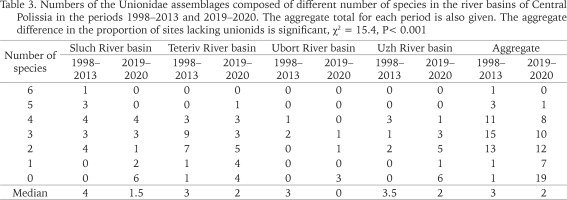
In 2019–2020, occupancy of sites by unionids had declined in all four rivers (Tables 3 and 4), to a lesser extent in the Teteriv than elsewhere. Of 24 individual comparisons (four river systems, six species), 21 show a decline in frequency, three an increase, and two no change, these being the absence of Anodonta spp. on both occasions in the Ubort. Given the small number of sites in each river, particular instances might arise by chance, but it is notable that P. complanata, present in all four rivers in 1998–2013, has completely disappeared.
A more precise assessment can be made by considering those sites sampled on both occasions. Full details of these sites are shown in the Appendix 1. Table 5 shows the overall balance of losses and gains by species in terms of occurrence. Overall, the difference is significant, χ2 = 19.2, P< 0.001. Only A. cygnea, and to a lesser extent, U. crassus, deviate from the general trend. These results are in accord with those shown in Table 4, based on more samples.
DISCUSSION
The Unionidae began to disappear from many water bodies in Ukraine at the turn of the century; three species, namely U. crassus, P. complanata and A. cygnea, were worst affected (Shevchuk et al. 2019). However, from 1998 to 2013, the Unionidae assemblages (in terms of species diversity and assemblage density) in the waterbodies of Central Polissia considered here were among the best in the country. The Sluch River basin in Zhytomyr Oblast had the highest rates of U. crassus (43%) and P. complanata (33%) occurrence over the indicated time. For A. cygnea, this indicator was also one of the highest (33%). In Ukraine in this period, the average values of these indicators were 15%, 10%, and 1%, respectively (Shevchuk et al. 2019). These species are now registered in the latest edition of the Red Book of Ukraine (2021). It is notable that at a single site in the Sluch basin, on the Tnia River, at the village of Sokolov, all six species were found, and five were found together at three more, the Sluch River, Baranivka, and Myropil and in the Smolka River, all in Zhytomyr Oblast. While no sites with more than four co-existing species were found in the other basins, all had between two and four species, except for one site in the Teteriv basin with a single species, and one that lacked any. Notably, P. complanata was recorded in all the basins. As expected, the tolerant species, U. pictorum, U. tumidus, A. anatina, occurred at high frequencies in all basins.
Comparing data collected in 1998–2013 to data obtained in 2019–2020, it is apparent that the frequency of occurrence has declined overall. Further, not only were more sites lacking any unionids, but only one site held five species. The median richness of sites has decreased. Given the small number of samples from some basins, differences between them are hard to evaluate, but of the two sampled most extensively, the Sluch appears to have suffered more than the Teteriv, which now appears marginally the richer of the two.
Our results confirm a pattern of general decline in the quality and biodiversity of the water bodies in Central Polissia over the last decade. Out of 24 sites sampled in both periods, only one, the Teteriv River, Korchak village site has retained the whole of its recorded fauna through to 2019–2020 (Appendix 1). The most striking decline is the apparent elimination of P. complanata. This species, already in the Red Book of Ukraine (2021), was already known to be heading for extinction in Ukraine (Korniushyn 2002).
While the data are scarce, the other two endangered species, U. crassus and A cygnea appear to have suffered less. When even earlier records are considered, however, a wider distribution of both species is shown by data from the 1970’s and 1980’s. A cygnea, absent from the Ubort basin in the sites considered here on both occasions, was so recorded earlier. Local extinctions will have been occurring over several decades. Even the more abundant species, U. pictorum, U. tumidus, and A. anatina, show great losses. Given the role of unionids in maintaining water quality, urgent action is needed to reverse these declines.


